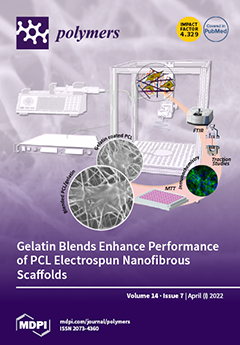In this work, titanium dioxide (TiO
2)-incorporated rice straw fiber (RS)/poly(butylene succinate) (PBS) biocomposites were prepared by injection molding with different TiO
2 powder loadings. The RS/PBS with 1 wt% TiO
2 demonstrated the best mechanical properties, where the flexural strength and
[...] Read more.
In this work, titanium dioxide (TiO
2)-incorporated rice straw fiber (RS)/poly(butylene succinate) (PBS) biocomposites were prepared by injection molding with different TiO
2 powder loadings. The RS/PBS with 1 wt% TiO
2 demonstrated the best mechanical properties, where the flexural strength and modulus increased by 30.34% and 28.39%, respectively, compared with RS/PBS. The non-isothermal crystallization of neat PBS, RS/PBS composites, and titanium-dioxide-incorporated RS/PBS composites was investigated by differential scanning calorimetry (DSC) and X-ray diffraction (XRD). The non-isothermal crystallization data were analyzed using several theoretical models. The Avrami and Mo kinetic models described the non-isothermal crystallization behavior of neat PBS and the composites; however, the Ozawa model was inapplicable. The crystallization temperature (
), half-time of crystallization (
), and kinetic parameters (
) showed that the crystallizability followed the order: TiO
2-incorporated RS/PBS composites > RS/PBS > PBS. The RS/PBS with 1 wt% TiO
2 showed the best crystallization properties. The Friedman model was used to evaluate the effective activation energy of the non-isothermal crystallization of PBS and its composites. Rice straw fiber and TiO
2 acted as nucleating agents for PBS. The XRD results showed that the addition of rice straw fiber and TiO
2 did not substantially affect the crystal parameters of the PBS matrix. Overall, this study shows that RS and TiO
2 can significantly improve the crystallization and mechanical properties of PBS composites.
Full article






